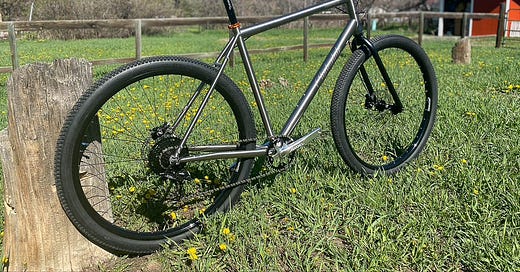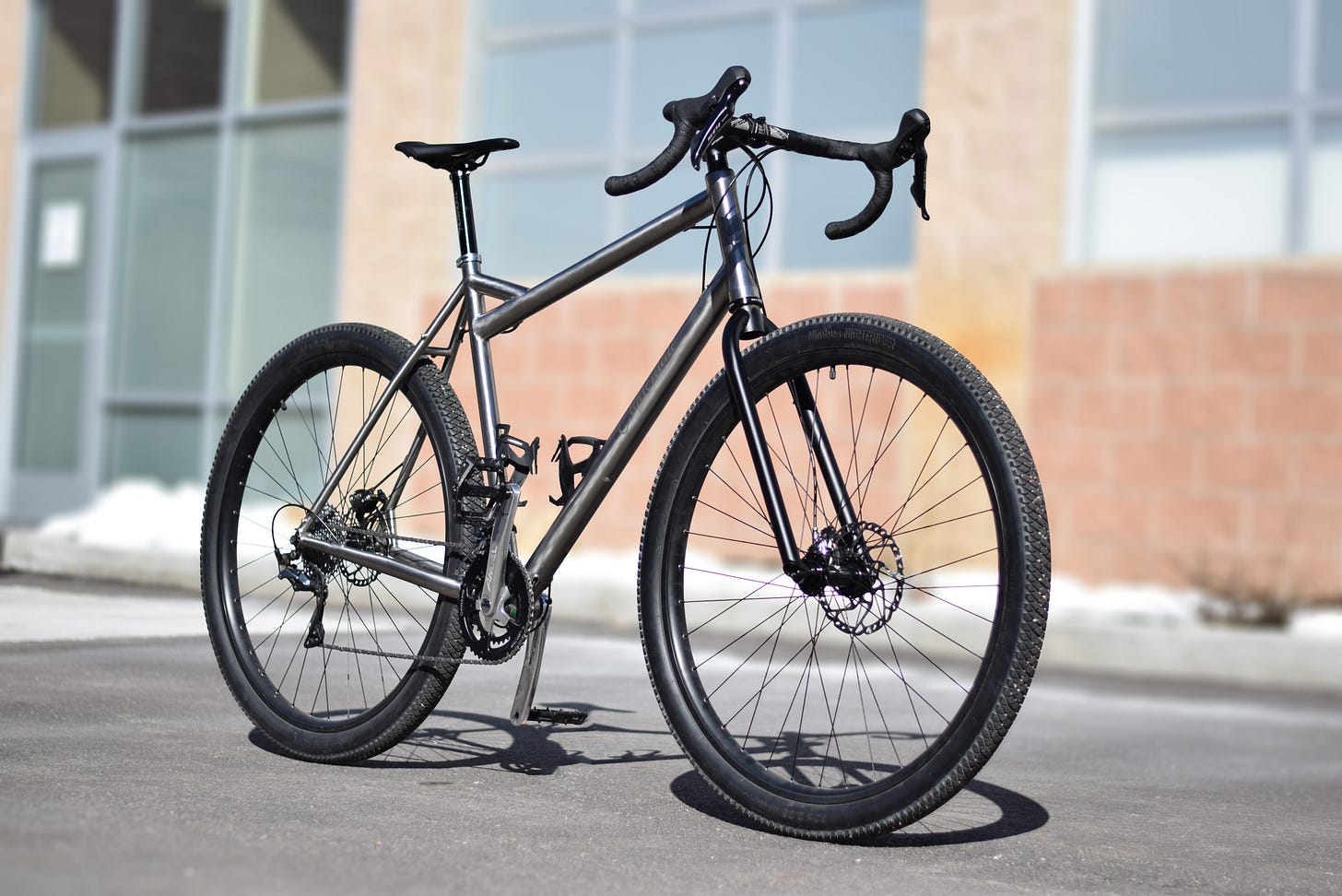More on 32” and 750D Tires
Calculating proportional rider sizes as well as cadences required for Pro Tour sprints
Regarding my column on 36” and 32” tires:
Dear Lennard,
I'm glad to see your columns again.
I do have a question about your logic.
I don't want to dissuade a rider from using a motor. It is just that I don't think that height per se is a justification.
Consider, if an XL rider needs a motor to spin up 32" wheels, should a 6'0" rider likewise need a motor to spin up 29" wheels so that they feel like 24"? The argument, of course, extends for other size riders.
Moreover, if the wheels are proportional to the size of a rider, then should not the strength of an XL rider be greater than that of an L rider.
If one wants a motor for giggles, etc. then go for it. I just don't get using size for the justification.
Ray
Dear Ray,
Point taken. In this particular case, however, the Nimbus rims and tires (made for unicycles) are so disproportionately heavy, and the tires so stiff and thick, that they cost the rider disproportionately more energy. That would make it impossible for the XL rider on a 32er to compete with the L rider on 700C/29” wheels and tires.
I agree with your contention in principle, and if the existing 32” wheels and tires were of similar construction and quality as the rims and tires in the other sizes, then I think you would see taller riders competing successfully on them against smaller riders on standard racing bikes. When accelerating or climbing, I think those wheels and tires would make it impossible to stay with other riders of similar fitness. However, if the tires and rims were half the weight of the Nimbus ones, thus in proportion to the weights of smaller wheels and tires, the rims were aerodynamic and the tires supple, then I could imagine a perhaps 6’10” rider being competitive in cycling events on a 32er.
We’ve made 32ers for some very powerful riders; one who comes to mind is a 6’11”, 290-pound, young NBA basketball player. While he was an intimidating physical specimen able to toss that heavy 32er titanium bike around, I think that the wheels and tires were still so heavy that he could still not throw it around as easily as a similarly-fit young 5’9” athlete could throw around a top-quality bike in their size.
Lighter, more aerodynamic 32” rims may exist in Nextie carbon ones, although unlike last week when I could view them, now I get a popup saying that, “This Connection Is Not Private. This website may be impersonating “www.nextie.com” to steal your personal or financial information”. Alternatively, lighter 32” aluminum rims can be solved without a huge investment, as bending an existing aluminum rim extrusion into a bigger hoop does not require expensive new tooling.
Clincher tires in a new size are a different story, however, because cutting a tire mold is so costly. Since it was cost-prohibitive to make a new tire in a different size, early experimentation with 29” MTB tires with popular MTB tread patterns was done by using stitched-together tires. Testers cut crosswise across 26” MTB tires and chopped chunks out of other 26” MTB tires of the same model. They sewed those chunks into the cut-across 26” ones to make knobby tires with 622mm bead diameter to fit on 700C rims. That’s why it’s so extraordinary that WTB has created two new tires in a new size: 750D.
This brings me to clarify some points regarding rider size and wheel size. My philosophy has long been to make as much of the bike proportional to the rider as possible. First, keeping the bike in similar proportion as 5’8”-6’1” riders on 700C/29” wheels gives you riders around 6’1”-6’7” for 750D tires, 6’4”-6’10” guys on 32” and 7’3”-7’10” riders on 36”.
It makes sense that everything is little on bikes for little kids. A kid’s first bike has 12” wheels and 100mm cranks, as well as a tiny saddle and handlebar. A couple of years later, the child graduates to a 16”-wheel bike with 130mm cranks, maybe followed by a bike with 20” wheels and 140mm cranks, and after a couple more years to a 24”-wheel bike with 150mm cranks. If that makes obvious, intuitive sense to people, does it make sense, with road bikes anyway, that adult bikes all have the same size wheels and essentially the same length cranks, despite the wide variation in human anatomy among adults?
Maybe 15 years ago, I consulted with sport scientist/coach/physiologist Allen Lim and a few riders from the Slipstream-Chipotle (now EF-Education Plus) team Lim worked for at a low-velocity wind tunnel in Fort Collins, CO. I provided some 190mm cranks to the team for 6’4” Magnus Bäckstedt and later, 6’5-1/2” Johan Vansummeren, both of whom are Paris-Roubaix winners. Lim said they experimented with them and liked them, though they ultimately did not race with them. It came down to gearing limitations, which could also be translated as wheel-size limitations.
Bäckstedt’s job on the team was often to lead out the team’s sprinter, Julian Dean, and the gearing of his bike simply made using the 190mm cranks impossible, something a wheel size like 750D or 32” could have conceivably alleviated. Front shifting is unreliable if using chainrings bigger than the front derailleur was designed for. Same goes for non-round chainrings, and using the ovoid Osymetric chainrings popularized at the time by Bradley Wiggins and Chris Froome winning the Tour de France on them was not possible anyway for Bäckstedt, because he was so strong that he folded the Osymetric rings over when he tried sprinting on them! It boggles the mind to think what he could have done to them with an even longer crankarm!
With the 700x23C tires being raced on at the time, a 53x11 results in a 127” gear, or 399” (0.0063 mile) with each pedal rotation. To lead Dean out in that gear at 40mph required a cadence of (40mi/hr)/(60min/hr * .0063mi/rev) = 106 rev/min, or 106 RPM. That cadence is unrealistic with a 190mm crank. But if there were 28mm-wide fast road tires in 750D size, the tire diameter would be 48mm larger than 700x23C tires, and that 53x11 gear would instead be a 136” gear, which means it goes 427” per revolution (0.00674 mile), and the cadence at 40mph becomes a more manageable 98 RPM (or switching to a 54-tooth chainring gets the required cadence down to 96 RPM). And had 32” wheels and tires been available, that cadence required would have dropped to 94 RPM (or 92 RPM with a 54-tooth chainring). But alas, no such bikes, tires or wheels exist at the Pro Tour level, so tall riders must scale down what’s possible for them similarly to how small riders are put at a disadvantage by the UCI limit on bike weight; it’s proportionately heavier for them than it is for bigger riders whose bikes weigh the same.
Anyway, 32” wheels smooth the terrain and carry incredible angular momentum, and if the tires were as supple as good 700C tires, you could expect a reduction in rolling resistance due to the longer contact patch. Then, if the rim weight and tire weight on 32ers stayed in the same proportions as with top-quality 700C/29” ones, I think you could see riders winning races on them. But I don’t think anybody could do so on the Nimbus 32” tires and rims.
― Lennard
Dear Lennard,
I am 6 feet 9 inches tall and weight 430 pounds. When I was in the process of having my current bike custom built, the builders wanted me to go with smaller wheels that could handle my weight, so the bike has 26-inch wheels. So did the previous bike, and each set of wheels seems to make it about three years before needing a re-build.
Lately I've been seeing bikes with bigger wheels being advertised for big guys. I've been skeptical, thinking, "I destroy everything." And I mean seats, seatposts, crankarms, tires, pedals, chains. And before I drop $8,000 for a bike with big wheels, I'll ask you what you think? What is the ratio of weaknesses caused by a bigger wheel vs the benefits of... well, I actually don't know the benefits. Or to simplify the question, can a 32- or 36-inch wheel be appropriate for a really heavy guy?
Eric
Dear Eric,
Yes, they can be, and for you, probably are appropriate. As I said in the previous answer, I consider your height to be best served with 32-inch wheels; gearing and proportionality would work better in that size for you. Thanks to a wider bracing angle because of their smaller diameter, 32” wheels would be stiffer laterally than 36-inch wheels.
If we were to build you a set of 32” wheels with the 36-hole, 1,087-gram Nimbus Dominator2 rims I describe here, I would expect them to hold up very well for you. On, for instance, our Clydesdale BFG 32er or eBFG e-bike, we use wider hubs, namely 12x157mm rear and 15x110mm Boost fork spacing. This provides the wide spoke-bracing angle to the rim despite its large diameter that your former builders were seeking by having you shrink your wheel size to 26”. This, combined with 36 butted spokes and the beefy Nimbus rims, makes for a very strong wheel.
As I explained last week, the Nimbus rims and tires are made for big guys on unicycles to huck off big drops and land with their full weight on a single wheel with no suspension. Your 430 pounds is within the capabilities of a rim that a 200-pound+ unicycle rider could huck drops with. The 1,160-gram Nimbus Nightrider Lite 32” tires I expect would also last you a long time.
― Lennard
As a frame builder, Lennard Zinn has been designing and building custom bicycles for over 42 years; he founded Zinn Cycles in 1982. His Tech Q&A column on Substack follows his 35-year stint as a technical writer for VeloNews (from 1987 through 2022). He is a former U.S. National Cycling Team member and author of many bicycle books including Zinn and the Art of Mountain Bike Maintenance, Zinn and the Art of Road Bike Maintenance, and The Haywire Heart. He holds a bachelor’s degree in physics from Colorado College. Readers can send brief technical questions to: veloqna@comcast.net.
Follow Lennard Zinn on Substack, Strava, X, Instagram, LinkedIn, or Facebook.






